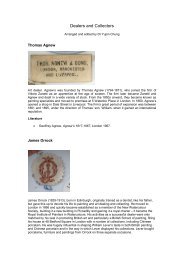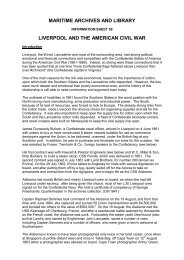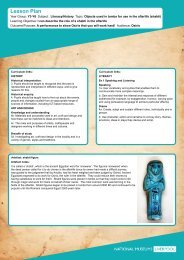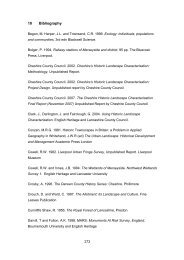women in maritime records - National Museums Liverpool
women in maritime records - National Museums Liverpool
women in maritime records - National Museums Liverpool
You also want an ePaper? Increase the reach of your titles
YUMPU automatically turns print PDFs into web optimized ePapers that Google loves.
MARITIME ARCHIVES AND LIBRARYINFORMATION SHEET 67WOMEN IN MARITIME RECORDSIntroductionWomen can prove very difficult to trace <strong>in</strong> history, and this is particularly the case <strong>in</strong> porthistory. Many of the jobs carried out by <strong>women</strong> were casual or hidden away, often regardedas unimportant and have therefore gone largely unrecorded <strong>in</strong> the historical evidence wehave left today. However, various forms of <strong>records</strong> have survived, illustrat<strong>in</strong>g the role<strong>women</strong> played <strong>in</strong> port life. This <strong>in</strong>formation sheet provides details of sources available <strong>in</strong> theMaritime Archives & Library relat<strong>in</strong>g to <strong>women</strong> and their contribution to port economics.There is early evidence to show that <strong>women</strong> were employed <strong>in</strong> such fields as lighthousekeep<strong>in</strong>g, sail and flag mak<strong>in</strong>g, fitt<strong>in</strong>g out and clean<strong>in</strong>g ships on their return from sea. Later,<strong>women</strong> would adopt the more traditional car<strong>in</strong>g roles as stewardesses and matronsemployed by the large shipp<strong>in</strong>g companies.Women on the DocksThere is little evidence of the <strong>women</strong> who were employed <strong>in</strong> casual jobs on the docksthemselves. Evidence has been found, however, of <strong>women</strong> be<strong>in</strong>g employed by the MerseyDocks and Harbour Board <strong>in</strong> the 19 th Century as Lighthouse Keepers. This was usually <strong>in</strong>the case of wives and daughters tak<strong>in</strong>g over as keepers follow<strong>in</strong>g the death of a husband orfather. In 1835 it was recorded that two sisters, Anne and Cather<strong>in</strong>e Urmson, could takeover from their late father as keepers of Bidston Lighthouse as they were deemed"competent" by the dock committee. They were to receive the same pay as their late father,to be split between them. (MDHB/MP/1/5)The Mersey Docks and Harbour Board were also concerned with ma<strong>in</strong>ta<strong>in</strong><strong>in</strong>g security on thedocks, <strong>in</strong> particular the grow<strong>in</strong>g problem of thiev<strong>in</strong>g from ships and warehouses. In 1814evidence for the need for a special dock police force cited the problems of gangs of 40-50<strong>women</strong> who regularly thieved from the coffee ships. (MDHB/DT/10).... the regular system of plunder now carried on upon the dock quays, which Iam compelled to be a daily witness of a gang consist<strong>in</strong>g pr<strong>in</strong>cipally of <strong>women</strong> <strong>in</strong>number from forty to fifty are <strong>in</strong> constant attendance upon all the coffee ships, -whether lad<strong>in</strong>g or unlad<strong>in</strong>g. Some of these <strong>women</strong> I have known for fourteen orfifteen years and dur<strong>in</strong>g that time, thiev<strong>in</strong>g on the quays has been their soleoccupation, which they have carried on unmolested and apparently without fearof apprehension.After the establishment of the Dock Police Force, <strong>women</strong> were regularly arrested for crimesrang<strong>in</strong>g from be<strong>in</strong>g drunk and disorderly to steal<strong>in</strong>g from ships, and were sent before thePolice magistrate to be sentenced, f<strong>in</strong>ed or released on bail.1
Some of the earliest evidence of <strong>women</strong> work<strong>in</strong>g <strong>in</strong> the docks can be found <strong>in</strong> the collectionof merchant papers belong<strong>in</strong>g to William Davenport, a lead<strong>in</strong>g merchant engaged <strong>in</strong> theslave trade <strong>in</strong> the 18 th Century.The collection <strong>in</strong>cludes many receipts for work carried out on ships, such as fitt<strong>in</strong>g them outand clean<strong>in</strong>g them on their return from sea. This <strong>in</strong>cludes a receipt for money paid to SarahWalker for her clean<strong>in</strong>g of the ivory tusks brought back to <strong>Liverpool</strong> on the Davenport ship,Badger, from Africa, 1777. Other receipts show monies paid to <strong>women</strong> such as MargaretCherry for tak<strong>in</strong>g up the anchor, to Alice Wynstanley for gorse (used <strong>in</strong> chalk<strong>in</strong>g the shipstimbers) and to Elizabeth Urmston for border and wallpaper used to decorate the cab<strong>in</strong> ofthe Badger. (D/DAV/10/12)RecordsReceipt detail<strong>in</strong>g payment to Sarah Walker for the clean<strong>in</strong>g of elephant's teeth (ivory),c.October 1777.D/DAV/10/12Receipt detail<strong>in</strong>g payment to Margaret Cherry for tak<strong>in</strong>g up the anchor, 7 October 1777.D/DAV/10/17Receipt detail<strong>in</strong>g payment to Alice Wynstanley for gorse, 24 October 1777.D/DAV/10/29Receipt detail<strong>in</strong>g payment to Elizabeth Urmston for paper and border for a cab<strong>in</strong> on theBadger, 9 February 1778.D/DAV/10/36Letter to Chairman, George Case Esq., from J. Richmond, H.M. Customs, describ<strong>in</strong>g theorganised theft of coffee on the docks by gangs of <strong>women</strong>. Given <strong>in</strong> evidence as part of aproposal to form a Dock Police Force, 20 July 1814.MDHB/DT/10Proceed<strong>in</strong>gs to magistrates at the <strong>Liverpool</strong> Dock Police Office, 1835:• Anne Hampson, sentenced to a month's imprisonment for steal<strong>in</strong>g iron at Pr<strong>in</strong>ces Dock,2 July 1835.• Susan McOdden appeared before the magistrate on suspicion of steal<strong>in</strong>g a bag ofperiw<strong>in</strong>kles from Clarence Dock, 31 July 1835.MDHB/Misc. VolumesResolution to appo<strong>in</strong>t Anne and Cather<strong>in</strong>e Urmson as keepers of Bidston Lighthouse.Proceed<strong>in</strong>gs of the Dock Committee, 3 November 1835.MDHB/MP/1/5Indenture of Apprenticeship of Mary Mill<strong>in</strong>ger to Stuart Matthews, as flagmaker for threeyears. Includes certificates of satisfactory service and discharge, 1901-1904.DX/1162
Voyage narrative of George Hiscock, The Barque Inverness-shire, c.1910.Description of a late even<strong>in</strong>g scene on the dockside <strong>in</strong>volv<strong>in</strong>g a group of seafarers and their<strong>women</strong> companions return<strong>in</strong>g to the ship.DX/1705Registration Card of Cooper's Wife, for the <strong>Liverpool</strong> Coppers' Friendly Trade & BurialSociety, 1920.DX/779War Time Women DockersAs with many professions dur<strong>in</strong>g war time, <strong>women</strong> were called on to take on jobs previouslydone by men, and this was the case <strong>in</strong> the <strong>Liverpool</strong> Docks dur<strong>in</strong>g the First and SecondWorld Wars.In early March 1916 due to the shortage of male dockers, around 30-50 <strong>women</strong> were takenon at Huskisson Dock, work<strong>in</strong>g as porters mov<strong>in</strong>g the unloaded cotton <strong>in</strong>to the Leyland L<strong>in</strong>ewarehouses on trucks. These <strong>women</strong> were employed for around three weeks untilopposition from the male dockers and their union forced the company to cease theiremployment.Around the same time <strong>women</strong> were also taken on by Harrison L<strong>in</strong>e at Toxteth Dock tounload their ships but aga<strong>in</strong>, the men refused to work with them and backed by the union,the employers ceased to employ females as dockers. By 20 March 1916, the <strong>Liverpool</strong>Courier reported that there were no longer any <strong>women</strong> employed as dockers. (Source:Women's Work on the Waterfront)Although <strong>women</strong> never worked as dockers aga<strong>in</strong> at <strong>Liverpool</strong> Docks, they were employeddur<strong>in</strong>g the Second World War as sweepers, aga<strong>in</strong> to replace the men who had been calledup to active service. These <strong>women</strong> worked <strong>in</strong> Alexandra, Gladstone and Seaforth Docks,sweep<strong>in</strong>g up the sheds after they had been emptied of their cargo of tea. This labour<strong>in</strong>tensive job did come with the added bonus of be<strong>in</strong>g able to salvage tea from the floors tosupplement tea rations. (Source: Women's Work on the Waterfront, p. 22)Women as SeafarersWomen were employed on ships from around the 1860s when shipp<strong>in</strong>g companies began tosee the benefit of employ<strong>in</strong>g <strong>women</strong> as stewardesses to care for their female passengersand children. As time passed, <strong>women</strong> seafarers began to be employed <strong>in</strong> all the traditionalfemale car<strong>in</strong>g roles such as matrons, stewardesses, laundresses, hairdressers and shopassistants. As shore based staff, <strong>women</strong> were employed by shipp<strong>in</strong>g companies as officeclerks, typists, cleaners and also <strong>in</strong> the shipp<strong>in</strong>g companies' own canteens.Shipp<strong>in</strong>g company archives can be a major source of <strong>in</strong>formation on the careers of late 19 thand 20 th Century merchant seafarers, as they often conta<strong>in</strong> staff <strong>records</strong> such as apprenticeand officer registers, wage books, as well as operational and fleet <strong>records</strong> such as logs andphotographs.The Maritime Archives & Library hold many examples of seafarers career papers, ma<strong>in</strong>lybelong<strong>in</strong>g to masters and seamen, although a small number do relate to <strong>women</strong> seafarers.3
RecordsDischarge Certificate of Elizabeth Cavan, stewardess on Cunard L<strong>in</strong>e vessel, Samaria,1875.SAS/24A/2/1Collection of letters and diaries written by Anne Smith, whilst serv<strong>in</strong>g as a stewardess withCunard L<strong>in</strong>e, 1920-1930.DX/1560Discharge Book and photograph of Kate Lilian Thomas, bookstall attendant for the CanadianPacific L<strong>in</strong>e, 1920-1922.DX/2271Diary of Rose Stott, stewardess on Cunard vessel, Samaria, round the world cruise, 1923.DX/1166Blue Funnel Wage Register, No. 44, show<strong>in</strong>g an entry for Victoria Drummond as tentheng<strong>in</strong>eer on the Anchises, earn<strong>in</strong>g a salary of £12 a month, 1922.OA/986Obituary for Victoria Drummond, MBE, first British woman to hold a Board of TradeCertificate as a mar<strong>in</strong>e eng<strong>in</strong>eer, Lloyd's Log, 1980.OA/1094Career papers of Hannah Leslie who served as a laundress for Cunard L<strong>in</strong>e, 1933-1947.DX/384Career papers of Mary Scott, bath attendant with Cunard L<strong>in</strong>e, 1946-1967.DX/1231Women as Passengers and EmigrantsIn the 19 th Century and early 20 th Century <strong>women</strong> chose to share the dangers and hardshipsof life at sea by accompany<strong>in</strong>g their capta<strong>in</strong> husbands on voyages, and quite often took theirchildren along. These <strong>women</strong> reta<strong>in</strong>ed their traditional fem<strong>in</strong><strong>in</strong>e roles on board by act<strong>in</strong>g ashomemaker. They too suffered the storms, sickness and boredom which came with life atsea, many of them writ<strong>in</strong>g diaries of their experiences. These diaries provide us with anexcellent <strong>in</strong>sight <strong>in</strong>to daily life at sea aboard a merchant ship and the Maritime Archives &Library holds examples of such narratives.RecordsVoyage account of Annie Stephens, wife of Capta<strong>in</strong> John Stephens, on board SS Anselmade Larr<strong>in</strong>aga on a return voyage from Eastham to Buenos Aires, April-September 1909.DX/11284
Narrative of Eliza Bradley, wife of Capta<strong>in</strong> James Bradley, master of <strong>Liverpool</strong> ship Sally,wrecked on the Barbary Coast, 1818.411.1 BRA/RTranscript of ship's log written by Eliza K<strong>in</strong>g, capta<strong>in</strong>'s wife on board Fearnought with smallson, <strong>Liverpool</strong> - Bombay - Rangoon, 1882-1883.SAS/35C/1/6Letter of thanks and letter of proposal of health to Capta<strong>in</strong> Black and his wife frompassengers aboard Antiope, 22 January 1879.SAS/23A/1/11At one time <strong>Liverpool</strong> was the most important port of departure for emigrants from Europeand it has been estimated that between 1830 and 1930 over n<strong>in</strong>e million emigrants sailedfrom <strong>Liverpool</strong> bound for a new life <strong>in</strong> the United States, Canada and Australia. TheMaritime Archives & Library holds documents and narratives record<strong>in</strong>g the experiences ofthose emigrat<strong>in</strong>g to a new land and a new life, a number of which are written by femaleemigrants.At the opposite end of the passenger experience are those who travelled <strong>in</strong> style on voyagesacross the Atlantic and cruised the oceans on holiday. The Maritime Archives & Library hascollected many orig<strong>in</strong>al documents and letters written home by passengers, <strong>in</strong>clud<strong>in</strong>g theletters of Gladys Cherry, who experienced one of the most famous shipp<strong>in</strong>g <strong>in</strong>cidents tohave ever taken place, the s<strong>in</strong>k<strong>in</strong>g of the Titanic. (DX/1522)Records.... The lower<strong>in</strong>g of the boat 70 feet <strong>in</strong>to the darkness seemed too awful, whenwe reached the water I felt we had done a foolish th<strong>in</strong>g to leave that big safeboat, but when we had rowed a few yards, we saw that great ship with her bowright down <strong>in</strong> the water ....Passenger's Contract Ticket, Tapscott's American Emigration Office, <strong>Liverpool</strong>. Ticket forElizabeth Lukes, <strong>Liverpool</strong> to Philadelphia, 17 March 1855.SAS/3/1/1/2/16Pamphlet entitled Female Emigration - Mr. Vere Foster. Report of the amount raised andthe manner <strong>in</strong> which it has been expended, 12 April 1856.SAS/3/1/1/1/4Voyage diary of Sarah Stephens, emigrant from Montgomeryshire, North Wales. Account ofher voyage on the Cardigan Castle from London to New Zealand, 30 September 1876 - 23January 1877.DX/1071/RTranscribed extracts from the diary of Sophie M. D. Luce, on a voyage from London to NewYork, 1857.DX/3245
Transcript extract from the diary of emigrant, Adelaide Parker Ebdon, on a voyage from<strong>Liverpool</strong> to U.S.A., 1891.SAS/3/1/8Letters of the Hon. Gladys Cherry, written on board the rescue ship Carpathia, follow<strong>in</strong>g thes<strong>in</strong>k<strong>in</strong>g of Titanic, 16 April 1912.DX/1522BibliographyROBINSON, Jane. Unsuitable for Ladies: An Anthology of Women Travellers. Oxford:Oxford University Press, 1994.ROBINSON, Jane. Wayward Women: A Guide to Women Travellers. Oxford: OxfordUniversity Press, 1990.CLIFFORD, Mary Louise & CLIFFORD, J.C. Women who kept the Lights: A History ofFemale Lighthouse Keepers. Virg<strong>in</strong>ia: Cypress Communications, 1993.BROWN, Alexander Crosby. Women and Children Last. London: Frederick Muller Ltd.,1961.BAIRD, Donal. Women at Sea <strong>in</strong> the Age of Sail. Halifax: Nimbus Publish<strong>in</strong>g Ltd., 2001.CORDINGLY, David. Hero<strong>in</strong>es and Harlots: Women at Sea <strong>in</strong> the Great Age of Sail.London: Pan Books, 2002.CREIGHTON, Margaret S. & NORLING, Lisa. Iron Men, Wooden Women: Gender andSeafar<strong>in</strong>g <strong>in</strong> the Atlantic World, 1700-1920. Baltimore: The Johns Hopk<strong>in</strong>s University Press,1996.GREENHILL, Basil. Women Under Sail. Devon: David & Charles Publish<strong>in</strong>g Ltd., 1970.NORLING, Lisa. Capta<strong>in</strong> Ahab had a Wife: New England Women & The Whalefishery,1720-1870. The University of North Carol<strong>in</strong>a Press, 2000.STARK, Suzanne J. Female Tars: Women Aboard Ship <strong>in</strong> the Age of Sail. London:Constable & Co., Ltd., 1996.STANLEY, Jo (Ed.). Bold <strong>in</strong> her Breeches: Women Pirates Across the Ages. London:Harper Coll<strong>in</strong>s Publish<strong>in</strong>g, 1995.TROLLOPE, Joanna. Britannia's Daughters: Women of the British Empire. London:Hutch<strong>in</strong>son & Co. (Publishers) Ltd., 1983.STANLEY, Jo. Women at Sea - Four Stewardesses <strong>in</strong> the 1930s. <strong>Liverpool</strong>: Jo Stanley,1987.READ, J. Gordon. Wives & Daughters: Experiences of Women Emigrants to the USA &Canada <strong>in</strong> the 19 th Century. <strong>Liverpool</strong>: <strong>National</strong> <strong>Museums</strong> & Galleries on Merseyside, 1994.6
BURLEND, Rebecca & BURLEND, Edward. A True Picture of Emigration. New Jersey:Citadel Press, 1974.THRELFALL, Helen. Emigration - A Bibliography of Works <strong>in</strong> the English Language held bythe Maritime Archives & Library. <strong>Liverpool</strong>: <strong>National</strong> <strong>Museums</strong> <strong>Liverpool</strong>, 1996.Women's Work on the Waterfront, 1916-1987. <strong>Liverpool</strong>: Women's History - Women's LivesGroup, Second Chance to Learn Project, 1987.InfoSheet67.kmMMM/DOCS/LR/30.1.067


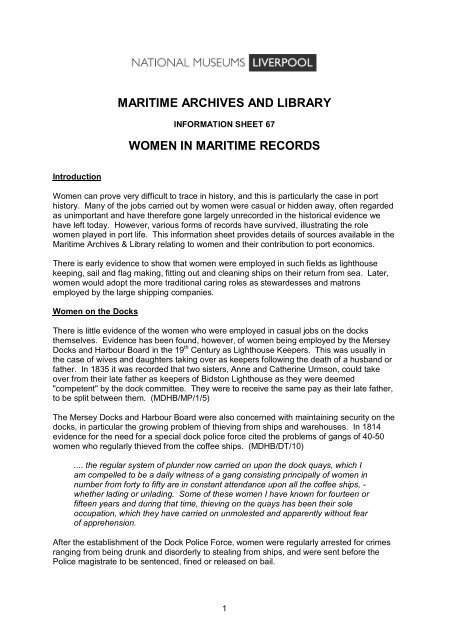
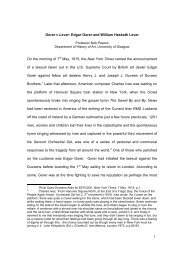
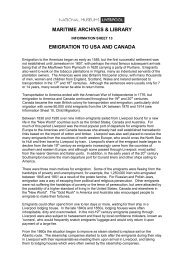
![Ancient Egypt trail [227kb .pdf] - National Museums Liverpool](https://img.yumpu.com/48998817/1/184x260/ancient-egypt-trail-227kb-pdf-national-museums-liverpool.jpg?quality=85)

